Effect of Calcium Stearate in the Mechanical and Physical Properties of Concrete with PCC and Fly Ash as Binders
Abstract
:1. Introduction
2. Materials and Methods
2.1. Specimens and Type of Testing
2.2. Specimens Production
2.3. Testing Protocol
2.3.1. Compressive Strength
2.3.2. Water Absorption
2.3.3. Infiltration of Chloride Ions
2.3.4. Accelerated Corrosion
3. Results
3.1. Compressive Strength
3.2. Water Absorption
3.3. Infiltration of Chloride Ion
3.4. Accelerated Corrosion
4. Discussion
4.1. Compressive Strength
4.2. Water Absorption
4.3. Infiltration of Chloride Ion
4.4. Accelerated Corrosion
5. Conclusions
Author Contributions
Funding
Acknowledgments
Conflicts of Interest
References
- National Standardization Committee. Portland Composite Cement; Indonesia National Standard SNI 15-7064-2004; National Standardization Committee: Bandung, Indonesia, 2004. [Google Scholar]
- Khongpermgoson, P.; Abdumatin, A.; Tangchirapat, W.; Jaturapitakkul, C. Evaluation of compressive strength and resistance of chloride ingress of concrete using a novel binder from ground coal bottom ash and ground calcium carbide residue. Constr. Build. Mater. 2019, 214, 631–640. [Google Scholar] [CrossRef]
- Saha, A.K. Effect of class F fly ash on the durability properties of concrete. Sustain. Environ. Res. 2018, 28, 25–31. [Google Scholar] [CrossRef]
- Sabo, N.; Shivhare, S.; Kori, K.K.; Chandrappa, A.K. Effect of fly ash and meta-kaolin on pervious concrete properties. Constr. Build. Mater. 2019, 223, 322–328. [Google Scholar] [CrossRef]
- Pachideh, G.; Gholhaki, M. Effect of pozzolanic materials on mechanical properties and water absorption of autoclaved aerated concrete. J. Build. Eng. 2019, 26, 1–10. [Google Scholar] [CrossRef]
- Yen, T.; Hsu, T.H.; Liu, Y.W.; Chen, S.H. Influences of class F fly ash on the abrasion-erosion resistance of high-strength concrete. Constr. Build. Mater. 2007, 21, 458–463. [Google Scholar] [CrossRef]
- Mandula, M. Durability of fly ash cement concrete pavement in cold areas. In Proceedings of the International Conference on Civil, Transportation and Environment (ICCTE), Guangshou, China, 30–31 January 2016; Atlantis Press: Beijing, China, 2016; pp. 55–59. [Google Scholar] [CrossRef] [Green Version]
- Uthaman, S.; Vishwakarma, V.; George, R.P.; Ramachandran, D.; Kumari, K.; Preetha, R.; Premila, M.; Rajaraman, R.; Mudali, U.K. Enhancement of strength and durability of fly ash concrete in seawater environments: Synergistic effect of nanoparticles. Constr. Build. Mater. 2019, 187, 448–459. [Google Scholar] [CrossRef]
- Neville, A.M. Properties of Concrete, 5th ed.; Pearson Education Limited: Harlow, UK, 2011; p. 98. [Google Scholar]
- Anjos, M.A.S.; Camoes, A.; Campos, P.; Azeredo, G.A.; Ferreira, R.L.S. Effect of high volume fly ash and metakaolin with and without hydrated lime on the properties of self-compacting concrete. J. Build. Eng. 2020, 27, 1–7. [Google Scholar] [CrossRef]
- Texeira, E.R.; Camoes, A.; Branco, F.G.; Aguiar, J.B.; Fangueiro, R. Recycling of biomass and coal fly ash as cement replacement material and its effect on hydration and carbonation of concrete. Waste Man. 2019, 94, 39–48. [Google Scholar] [CrossRef]
- Li, P.P.; Yu, Q.L.; Brouwers, H.J.H. Effect of PCE-type superplasticizer on early-age behaviour of ultra-high performance concrete (UHPC). Constr. Build. Mater. 2017, 153, 740–750. [Google Scholar] [CrossRef]
- Bautista, A.; Pomares, J.C.; Gonzales, M.N.; Velasco, F. Influence of the microstructure of TMT reinforcing bars on their corrosion behavior in concrete with chlorides. Constr. Build. Mater. 2019, 229, 1–11. [Google Scholar] [CrossRef] [Green Version]
- Benaicha, M.; Alaoui, A.H.; Jalbaud, O.; Burtschell, Y. Dosage effect of superplasticizer on self-compacting concrete: Correlation between rheology and strength. J. Mater. Res. Technol. 2019, 8, 2063–2069. [Google Scholar] [CrossRef]
- Ibragimov, R.; Fediuk, R. Improving the early strength of concrete: Effect of mechanochemical activation of the cementitious suspension and using of various superplasticizer. Constr. Build. Mater. 2019, 226, 839–848. [Google Scholar] [CrossRef]
- Shi, C.; He, T.; Zhang, G.; Wang, X.; Hu, Y. Effect of superplasticizers on carbonation resistance of concrete. Constr. Build. Mater. 2016, 108, 48–55. [Google Scholar] [CrossRef]
- Mora, E.; Gonzales, G.; Romero, P.; Castellon, E. Control of water absorption in concrete materials by modification with hybrid hydrophobic silica particles. Constr. Build. Mater. 2019, 221, 210–218. [Google Scholar] [CrossRef]
- Eskandari, H.; Nic, A.M.; Ghanei, A. Effect of air entraining admixture on corrosion of reinforced concrete. Procedia Eng. 2016, 150, 2178–2184. [Google Scholar] [CrossRef] [Green Version]
- Pandey, A.; Kumar, B. Evaluation of water absorption and chloride ion penetration of rice straw ash and microsilica admixed pavement quality concrete. Heliyon 2019, 5, 1–15. [Google Scholar] [CrossRef] [PubMed] [Green Version]
- Bagheri, A.; Ajam, A.; Zanganeh, H. Investigation of chloride ingress into concrete under very early age exposure conditions. Constr. Build. Mater. 2019, 225, 801–811. [Google Scholar] [CrossRef]
- Wang, L.; Dai, L.; Zhang, X.; Zhang, J. Concrete cracking prediction including the filling proportion of strand corrosion products. Materials 2017, 10, 6. [Google Scholar] [CrossRef] [PubMed] [Green Version]
- Du, F.; Jin, Z.; Xiong, C.; Yu, Y.; Fan, J. Effects of transverse crack on chloride ions diffusion and steel bars corrosion behavior in concrete under electric acceleration. Materials 2019, 12, 2481. [Google Scholar] [CrossRef] [PubMed] [Green Version]
- BaniAsad, E.; Dehestani, M. Incorporation of corrosion and bond-slip effects in properties of reinforcing element embedded in concrete beams. Structures 2019, 20, 105–115. [Google Scholar] [CrossRef]
- Maryoto, A.; Shimomura, T. Effect of prestressed force and size of reinforcement on corrosion crack width in concrete member. J. Eng. Sci. Tech. 2017, 12, 2664–2676. [Google Scholar]
- Haryanto, Y.; Gan, B.S.; Maryoto, A. Wire rope flexural bonded strengthening system on RC-beam: A finite element simulation. Int. J. Tech. 2017, 8, 132–142. [Google Scholar] [CrossRef]
- Maryoto, A.; Gan, B.S.; Hermanto, N.I.S.; Setijadi, R. Corrosion resistance of self-compacting concrete containing calcium stearate. J. Eng. Sci. Tech. 2018, 13, 3263–3276. [Google Scholar]
- Chari, M.N.; Naseroleslami, R.; Shekarchi, M. The impact of calcium stearate on characteristics of concrete. Asian J. Civ. Eng. 2019, 20, 1–14. [Google Scholar]
- Stolz, H.J. Oleochemicals—important additives for building protection. ZKG Int. 2008, 61, 78–86. [Google Scholar]
- Du, S.; Wu, J.; AlShareedah, O.; Shi, X. Nanotechnology in cement-based materials: A review of durability, modeling, and advanced characterization. Nanomaterials 2019, 9, 1213. [Google Scholar] [CrossRef] [Green Version]
- Maryoto, A.; Gan, B.S.; Aylie, H. Reduction of chloride ion ingress into reinforced concrete using a hydrophobic additive material. J. Teknol. 2017, 79, 65–72. [Google Scholar] [CrossRef] [Green Version]
- Concrete and Aggregates. ASTM 04.02; Concrete and Aggregates: Mérignac, France, 2018. [Google Scholar]
- National Standardization Committee. Specification for Waterproof Reinforced Concrete; Indonesia National Standard, SNI 03-2914-1992; National Standardization Committee: Bandung, Indonesia, 1992. [Google Scholar]
- Quraishi, M.A.; Kumar, V.; Abhilash, P.P.; Singh, B.N. Calcium stearate: A green corrosion inhibitor for steel in concrete environment. J. Mater. Environ. Sci. 2011, 2, 365–372. [Google Scholar]
- Indian Electronic Theses and Dissertasion. Available online: https://shodhganga.inflibnet.ac.in/bitstream/10603/15804/6/06_chapter%201.pdf (accessed on 3 March 2020).

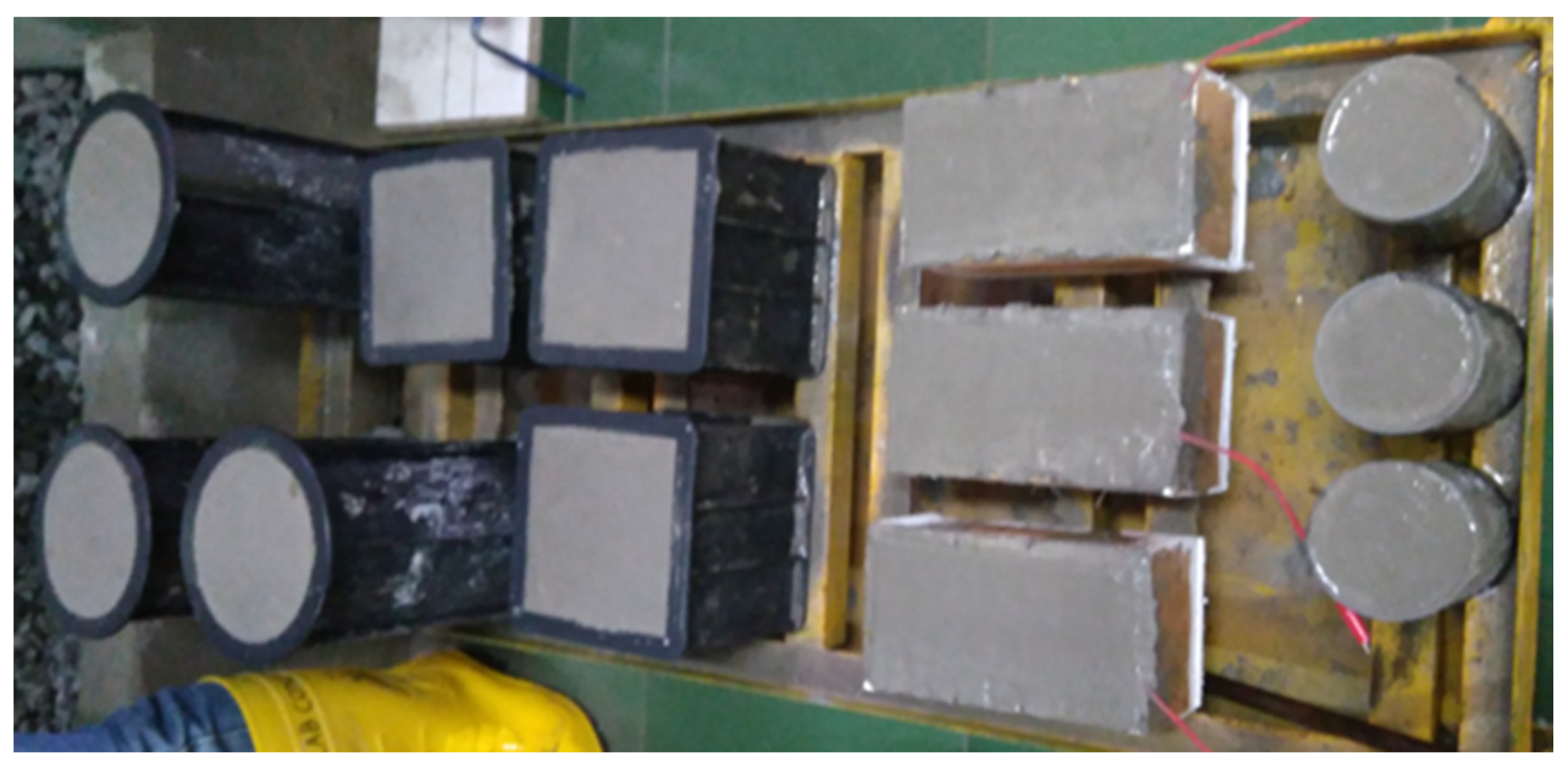
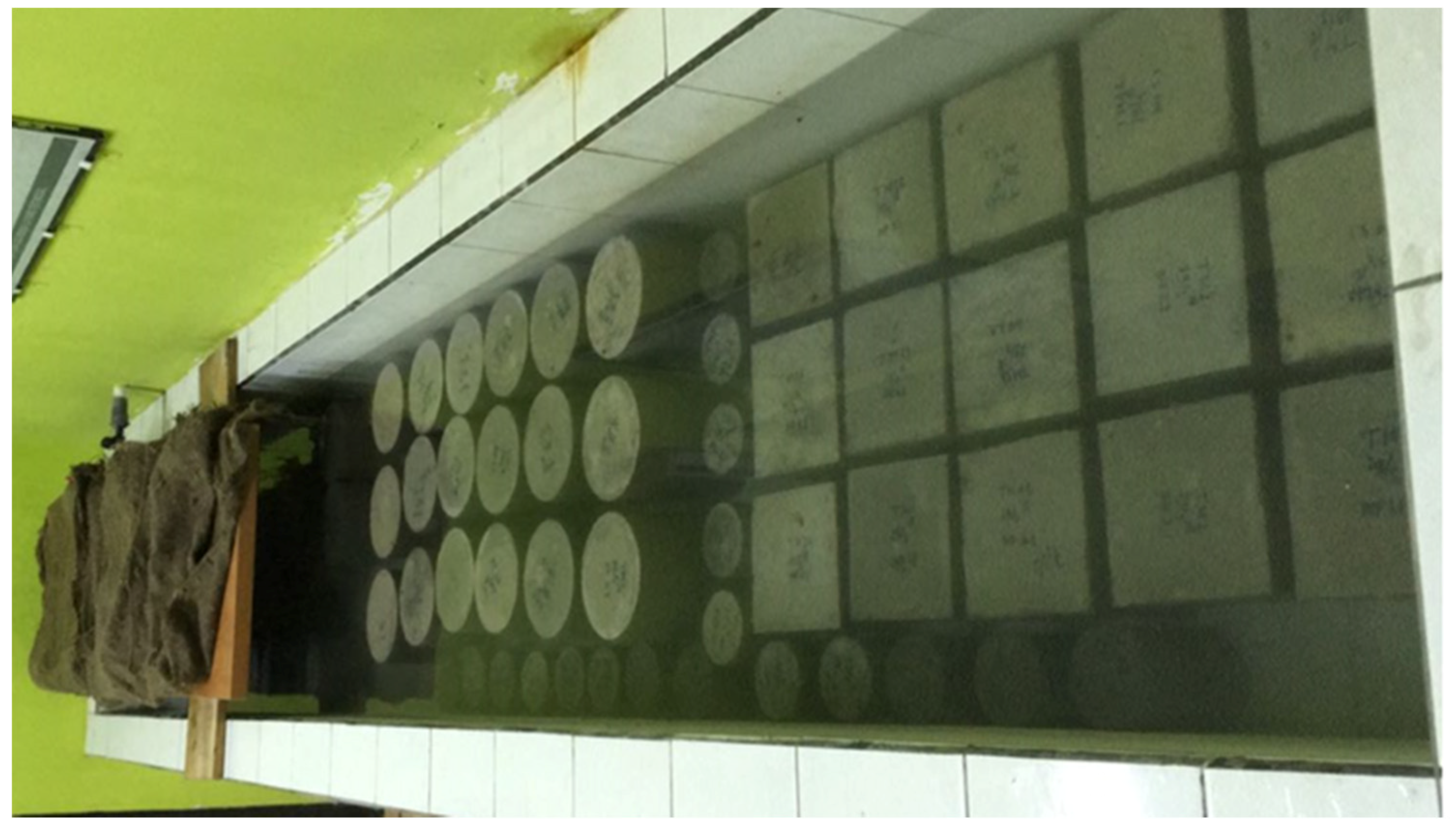
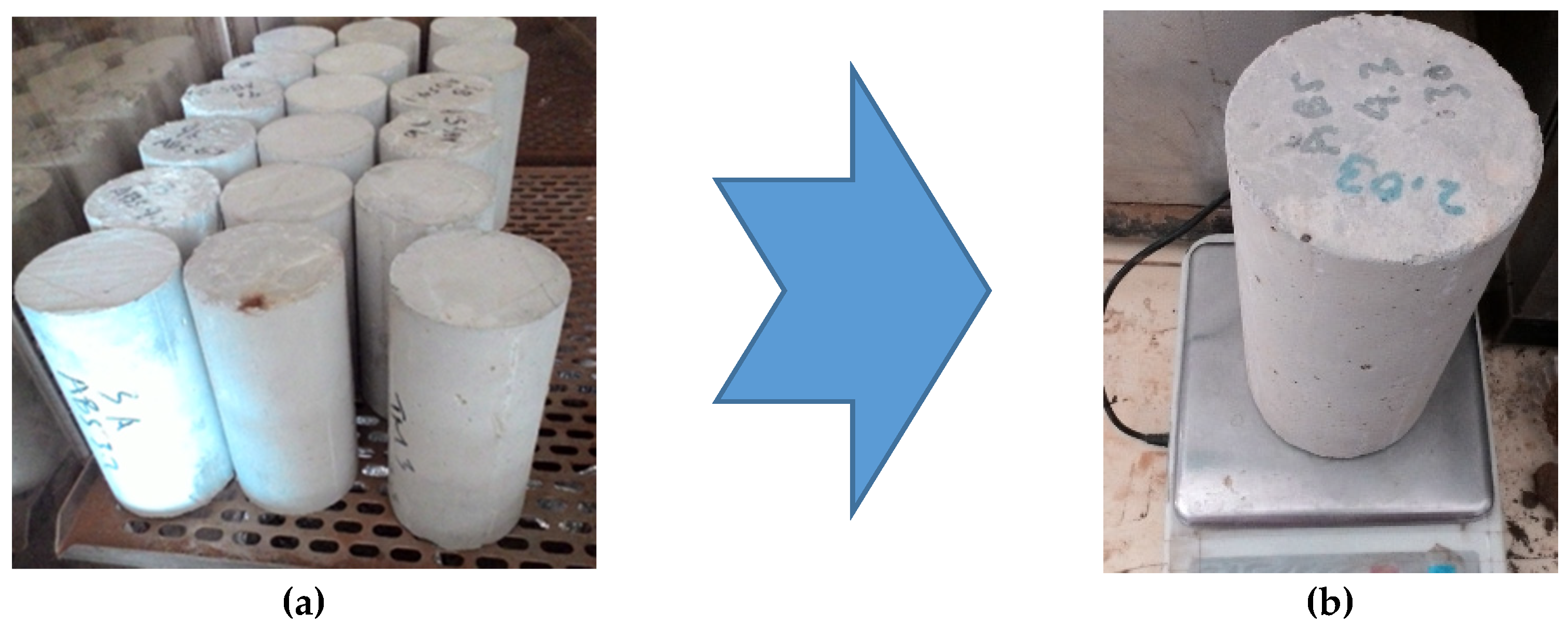


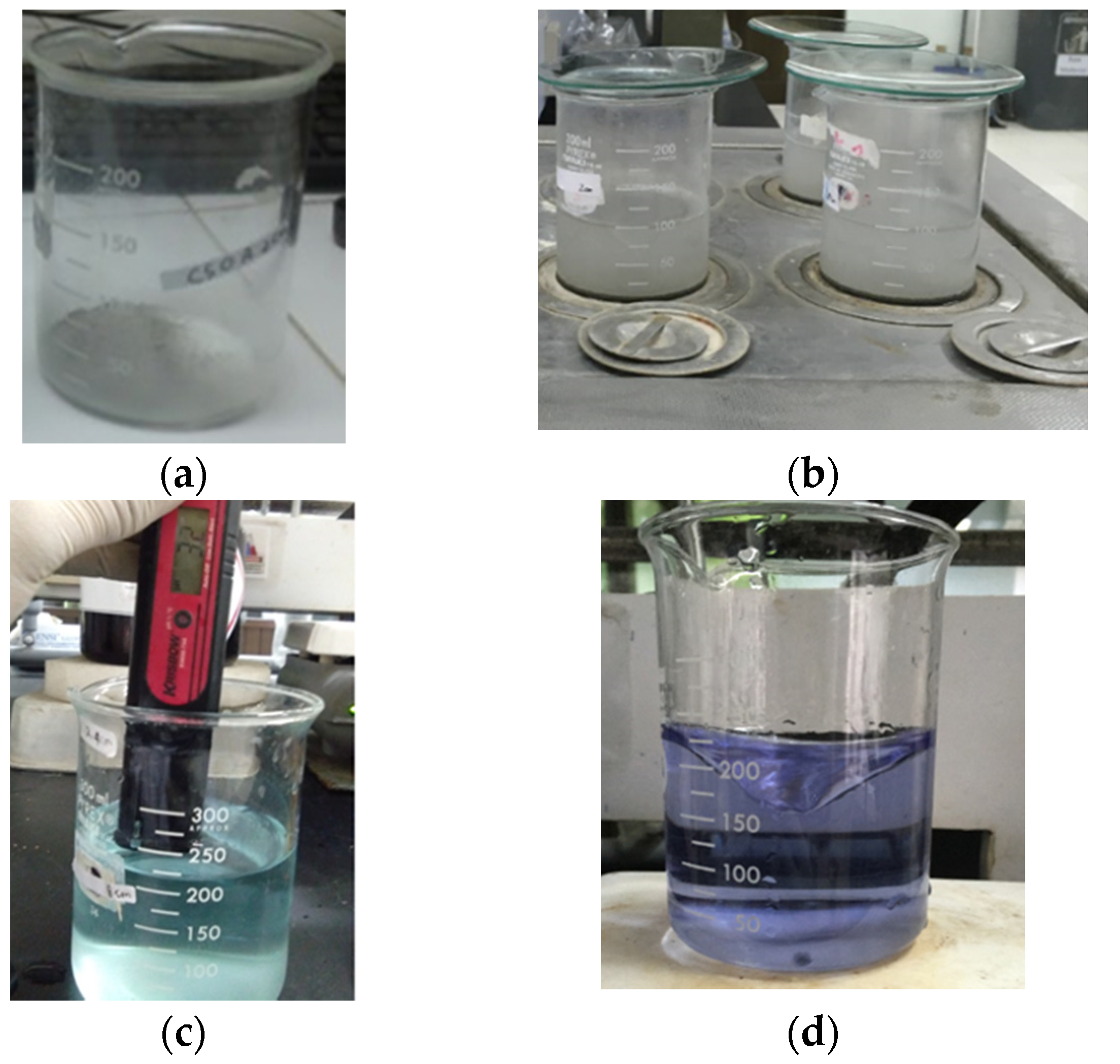
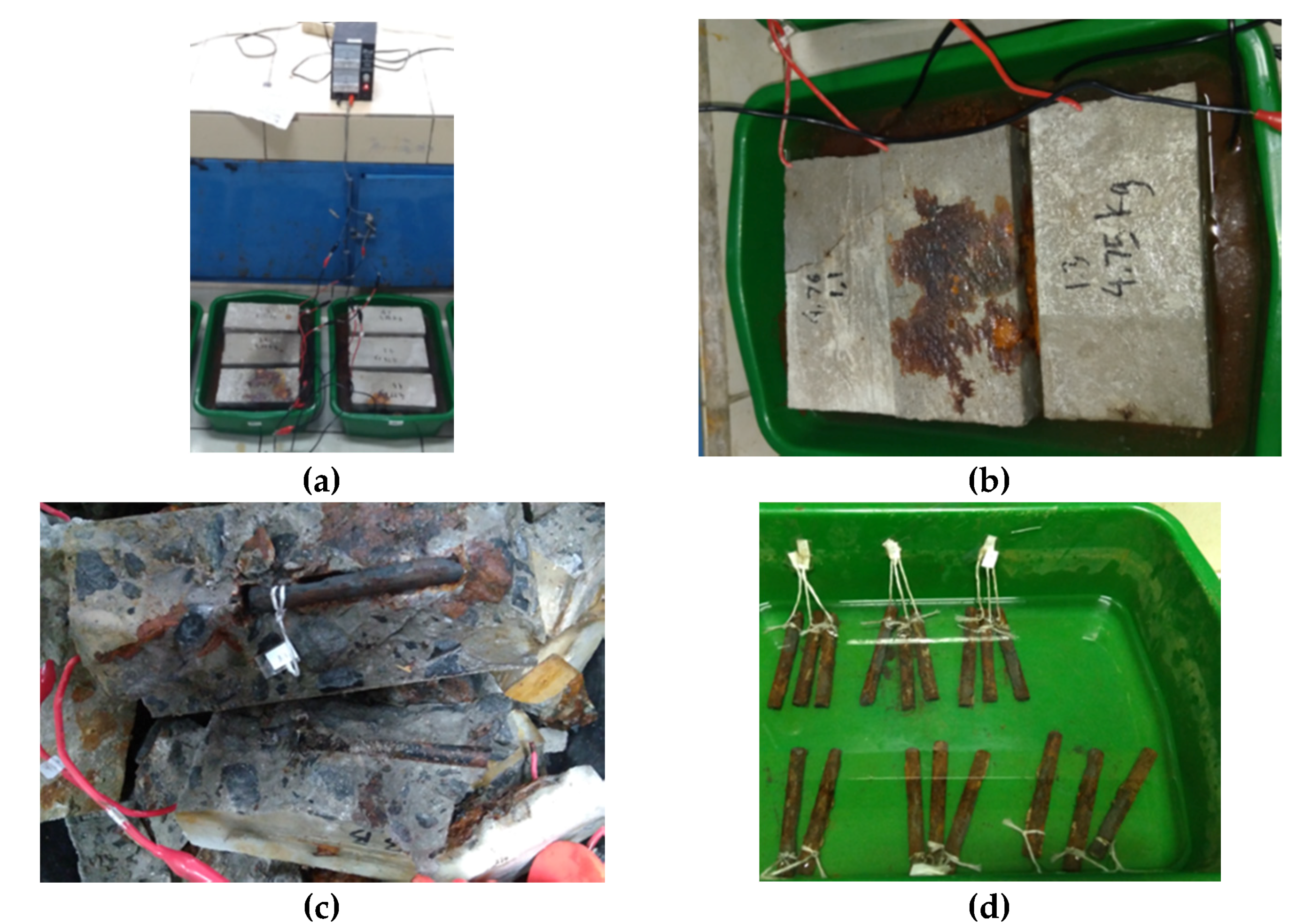


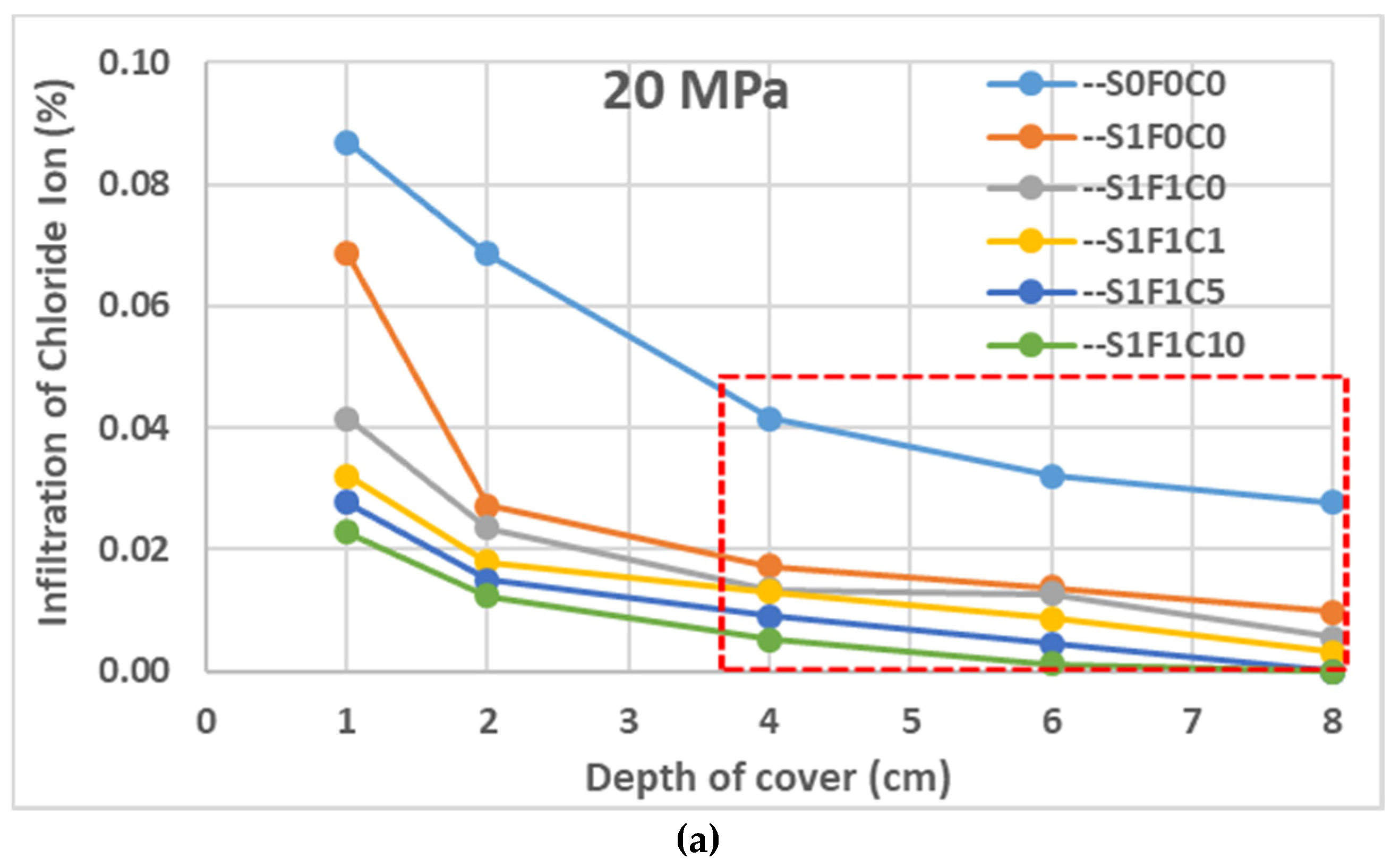

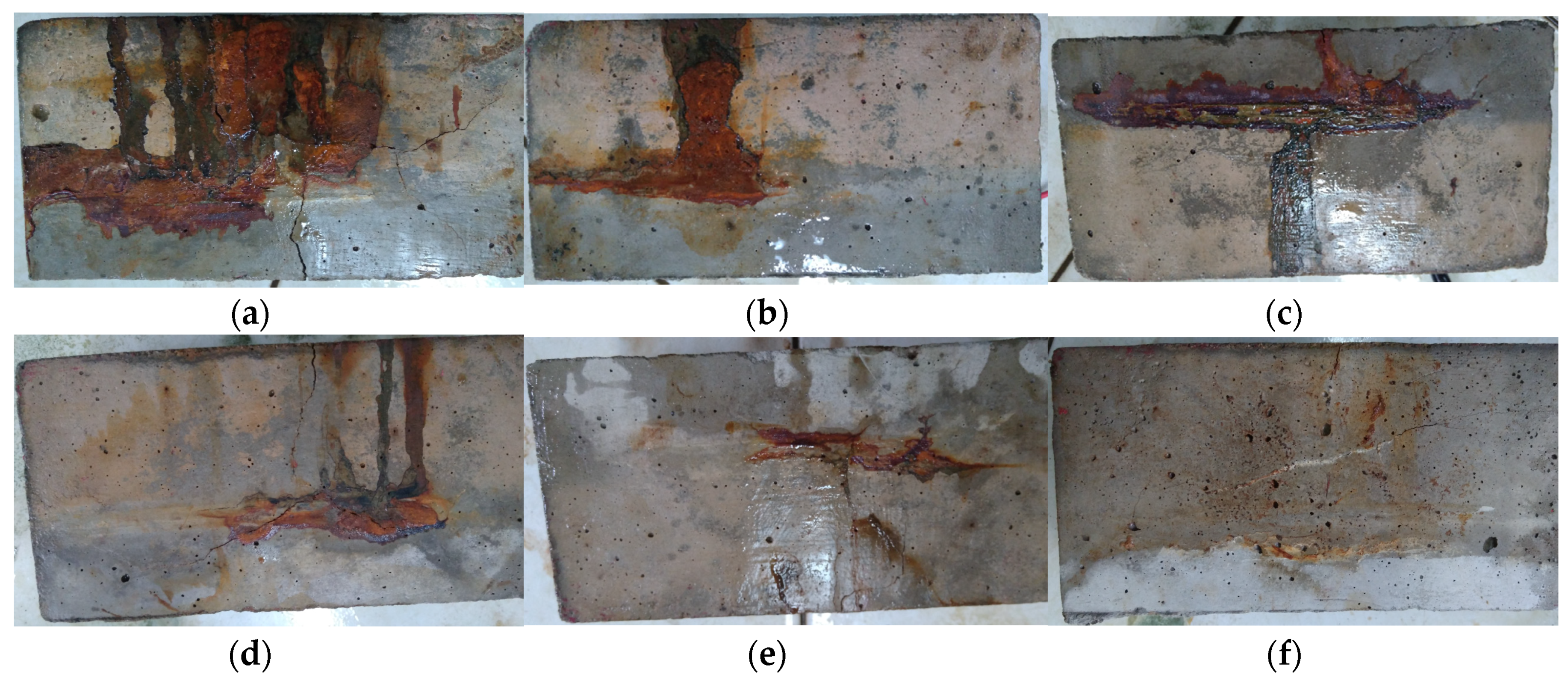



| Physical Characteristic | Analysis |
|---|---|
| Chemical formula | Ca(C18H35O2)2 |
| Appearance | Fine white powder |
| Melting point | 120 °C |
| Free fatty acid | Maximum of 0.5% |
| Loss on drying | Maximum of 2% |
| Metal content | 0.65 (ppm) |
| Specific gravity | 0.25 |
| Chemical and Physical Composition | SiO2 | Al2O3 | Fe2O3 | CaO | MgO | SO3 | LOI | AE | IR |
|---|---|---|---|---|---|---|---|---|---|
| PCC (%) | 19.6 | 5.84 | 3.93 | 64.55 | 1.26 | 2.31 | 1.32 | 0.63 | 0.56 |
| Indonesia National Standard for PCC | - | - | - | - | Max. of 6.0 | Max. of 4.0 | Max. of 5.0 | 0.6 | Max. of 3.0 |
| Fly ash (%) | 46.21 | 18.97 | 10.13 | 9.85 | 2.76 | 0.18 | 0.20 | - | 7.5 |
| Physical Characteristic | Result of Testing | SNI 15-7064-2004 (PCC) |
|---|---|---|
| Fineness with Blaine apparatus (m2/kg) | 396 | Min. of 280 |
| Fineness with a 45-µm mesh of residue (%) | 10.70 | - |
| Initial setting time (minutes) | 130 | Min. of 45 |
| Final setting time (minutes) | 263 | Max. of 375 |
| Expansion (%) | 0.04 | Min. of 0.80 |
| Compressive strength at 3 days (MPa) | 19.2 | Min. of 12.5 |
| Compressive strength at 7 days (MPa) | 24.8 | Min. of 20.0 |
| Compressive strength at 28 days (MPa) | 32.1 | Min. of 25.0 |
| False set (minutes) | 46.21 | Min. of 50 |
| Physical Properties | Sand | Crushed Stone |
|---|---|---|
| Specific gravity | 2.60 | 2.57 |
| Water absorption (%) | 3.40 | 2.50 |
| Density (tons/m3) | 1.57 | 1.48 |
| Fineness modulus | 2.80 | 6.72 |
| Clay content (%) | 6.72 | 1.35 |
| Materials | Code of Concrete at 20 MPa | |||||
|---|---|---|---|---|---|---|
| G2S0F0C0 | G2S1F0C0 | G2S1F1C0 | G2S1F1C1 | G2S1F1C5 | G2S1F1C10 | |
| Cement (kg) | 350 | 350 | 350 | 350 | 350 | 350 |
| Fly ash (%) | 0 | 0 | 10 | 10 | 10 | 10 |
| Sand (%) | 251.43 | 251.43 | 251.43 | 251.43 | 251.43 | 251.43 |
| Crushed stone (%) | 244.29 | 244.29 | 244.29 | 244.29 | 244.29 | 244.29 |
| Water (%) | 58.57 | 50.00 | 50.00 | 50.00 | 50.00 | 50.00 |
| Superplasticizer (%) | 0.00 | 0.25 | 0.25 | 0.25 | 0.25 | 0.25 |
| Calcium stearate (%) | 0.00 | 0.00 | 0.00 | 0.29 | 1.43 | 2.86 |
| Code of Concrete at 30 MPa | ||||||
| G3S0F0C0 | G3S1F0C0 | G3S1F1C0 | G3S1F1C1 | G3S1F1C5 | G3S1F1C10 | |
| Cement (kg) | 415 | 415 | 415 | 415 | 415 | 415 |
| Fly ash (%) | 0 | 0 | 10 | 10 | 10 | 10 |
| Sand (%) | 189.16 | 189.16 | 189.16 | 189.16 | 189.16 | 189.16 |
| Crushed stone (%) | 214.46 | 214.46 | 214.46 | 214.46 | 214.46 | 214.46 |
| Water (%) | 51.08 | 45.06 | 45.06 | 45.06 | 45.06 | 45.06 |
| Superplasticizer (%) | 0 | 0.25 | 0.25 | 0.25 | 0.25 | 0.25 |
| Calcium stearate (%) | 0 | 0 | 0 | 0.24 | 1.20 | 2.41 |
| Code of Concrete at 40 MPa | ||||||
| G4S0F0C0 | G4S1F0C0 | G4S1F1C0 | G4S1F1C1 | G4S1F1C5 | G4S1F1C10 | |
| Cement (kg) | 535 | 535 | 535 | 535 | 535 | 535 |
| Fly ash (%) | 0 | 0 | 10 | 10 | 10 | 10 |
| Sand (%) | 140.19 | 140.19 | 140.19 | 140.19 | 140.19 | 140.19 |
| Crushed stone (%) | 162.62 | 162.62 | 162.62 | 162.62 | 162.62 | 162.62 |
| Water (%) | 39.25 | 33.64 | 33.64 | 33.64 | 33.64 | 33.64 |
| Superplasticizer (%) | 0 | 0.25 | 0.25 | 0.25 | 0.25 | 0.25 |
| Calcium stearate (%) | 0 | 0 | 0 | 0.19 | 0.93 | 1.87 |
© 2020 by the authors. Licensee MDPI, Basel, Switzerland. This article is an open access article distributed under the terms and conditions of the Creative Commons Attribution (CC BY) license (http://creativecommons.org/licenses/by/4.0/).
Share and Cite
Maryoto, A.; Sthenly Gan, B.; Intang Setyo Hermanto, N.; Setijadi, R. Effect of Calcium Stearate in the Mechanical and Physical Properties of Concrete with PCC and Fly Ash as Binders. Materials 2020, 13, 1394. https://doi.org/10.3390/ma13061394
Maryoto A, Sthenly Gan B, Intang Setyo Hermanto N, Setijadi R. Effect of Calcium Stearate in the Mechanical and Physical Properties of Concrete with PCC and Fly Ash as Binders. Materials. 2020; 13(6):1394. https://doi.org/10.3390/ma13061394
Chicago/Turabian StyleMaryoto, Agus, Buntara Sthenly Gan, Nor Intang Setyo Hermanto, and Rachmad Setijadi. 2020. "Effect of Calcium Stearate in the Mechanical and Physical Properties of Concrete with PCC and Fly Ash as Binders" Materials 13, no. 6: 1394. https://doi.org/10.3390/ma13061394





